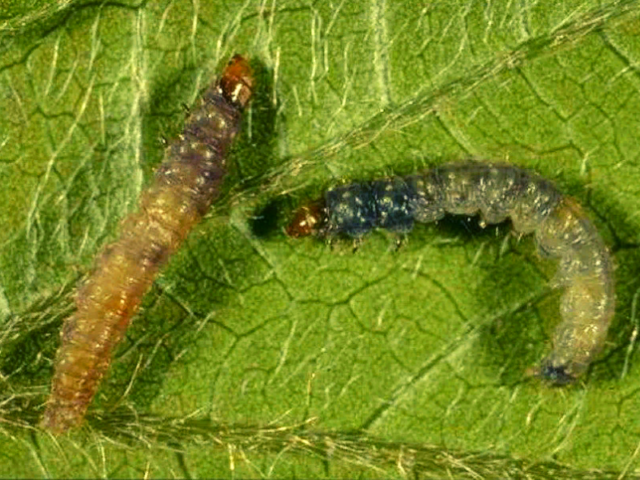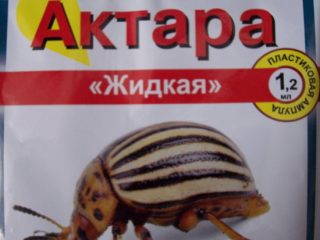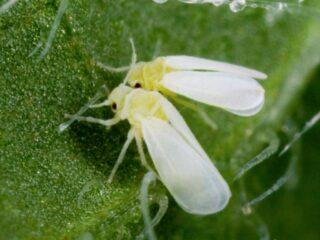Content
Grapes, like many other garden plants, often become victims of pests. One of the most dangerous insects for this crop is the cluster leaf roller, which destroys not only buds and flowers, but also formed clusters.

A small butterfly can cause great harm
What does a leaf roller look like on grapes?
The grape leaf roller, as seen in the photo, is a small, inconspicuous butterfly, the length of which is about 8 mm, and the wingspan is about 15 mm. When free, they are folded along the body in the shape of a bell.
The front trapezoidal wings of the insect are olive-brown or brownish-brown in color with a wide yellow-white border dotted with light gray dashes. On each of them, closer to the inner corner, ocher-yellow spots are clearly visible, spreading towards the front edge.
The triangular hind wings are gray - lighter at the inner corners and darker at the edges.
The eggs of the cluster budworm are so small (0.5-0.6 mm) that they are almost impossible to see with the naked eye.Immediately after laying, they look like translucent balls with a greenish tint, and by the time they ripen they acquire a yellowish-cream color.
The larva of this pest is small, about 10 mm in length, a caterpillar with a brown head and a yellow or gray-green body.
The length of the cluster leaf roller pupa does not exceed 6 mm. The color of the cover is yellow-brown with a green tint, the tip of the abdomen is yellow.
Three generations of pests change throughout the season. Butterflies of the first generation lay eggs on the buds or flowers of grapes, the second - on green, and the third - on ripe berries.

Leafroller caterpillars can be found in groups
What harm does
The grape leaf roller is a dangerous pest of grapes, which is compared to phylloxera in terms of the degree of damage. The cunning of the insect is that the butterfly is active throughout the entire season, infecting large areas of plantings.
And yet, it is not the butterfly itself that poses a danger to the grapes, but its caterpillar, which immediately after birth begins to devour the buds, forming wide and deep holes in them. Moreover, insects destroy not only part of the shell, but also the stamens and pistil.
After eating the first bud, the cluster leaf roller uses a web to attract the next one, then another and another, entwining the damaged parts of the plants with a dense web.
Unlike their predecessors, which feed on buds and flowers, third-generation grape budworm caterpillars eat berries from the inside, causing them to become dry and wrinkled.
Thus, during the period of its activity, one leaf roller can damage 40-60 buds or fruits. In addition, the active activity of the pest leads to damage to the generative buds.
If you do not control the bunch budworm on grapes, it can destroy more than half, and in especially large numbers, the entire crop.

Leaf rollers and leaves suffer from the pest
Symptoms of the lesion
The first sign of the presence of grape budworm on grapes is a dense web entangling the leaves, flowers and berries. Corroded leaves, buds and flowers, dry and rotten berries also indicate the harmful activity of a gnawing insect.

Traces of leaf roller activity are visible to the naked eye
Traces of leaf roller activity are visible to the naked eye
Reasons for appearance
The main reason for the appearance of cluster budworm on grapes is warm weather, during which the butterfly flight becomes more active.
The spread of pests is also facilitated by dense plantings, an abundance of weeds in the root zone, and ignoring preventive treatment of grapes against grape budworm.
How to get rid of leaf rollers on grapes
In order not to lose a significant part of the harvest, the fight against bunch budworm begins at the first signs of its appearance on the grapes. As a rule, this happens immediately after the kidneys swell. The method of exterminating the pest is chosen depending on the life cycle of the pest and the degree of damage to the plantings.
Preparations for leaf rollers on grapes
The most effective way to combat caterpillars is to treat grapes with chemicals against bunch budworm.
Experienced gardeners recommend using insecticides for this:
- Aktara;
- Karbofos;
- Aktellik;
- Spark;
- Inta Vir;
- Landing;
- Decis;
- Alatar;
- Ivanhoe, etc.
This is a systemic insecticide that allows you to destroy the leaf roller on grapes in just 2 applications, without accumulating in the fruits. Coragen is very economical, 2.5 ml is consumed per 10 liters of water. Working fluid consumption is up to 1 liter per bush. Thus, a solution of 1 package with a volume of 4 ml is enough for a single treatment of 16 bushes!
The grapes are processed before flowering or immediately after this in strict accordance with the instructions supplied with the preparation. Plants should be sprayed in dry, windless weather. It is better to do this in the evening, when the activity of the sun's rays will noticeably decrease.
Given the long waiting period for insecticidal preparations, these products cannot be used during the fruiting period. In this case, it is better to treat the grapes against the leaf roller with biological products such as Fitoverma, Bitoxibacillin, Lepidocid. After using such products, the berries can be eaten within three days.

There are a huge number of insecticides to combat bunch budworm.
Folk remedies
In case of focal lesions, you can use traditional methods of combating bunch budworm.
Spraying with the following means will help save grapes from the harmful activities of insects:
- Infusion of tobacco ash, for the preparation of which 500 g of ash is dissolved in 10 liters of water and infused for 24 hours. The prepared composition is diluted with water in a ratio of 1 to 2 and the grapes are sprayed with it. For a better effect, add a so-called adhesive to the working solution, which can be used as laundry or liquid soap (50 g per bucket).
- Celandine with wormwood - to prepare this remedy, combine chopped herbs (fresh or dry) in equal parts, pour boiling water in a ratio of 1x10 and cover with a lid. After the product has been infused for two days, it is boiled again, cooled and filtered. The resulting composition is diluted with water in a ratio of 1 to 2, an adhesive is added and the grapes are sprayed.
- A tincture of tomato tops, which is made as follows: 4 kg of tops are poured with a bucket of hot water and left to infuse for four hours. After this, the product is brought to a boil and cooled. The tops are discarded, and the remaining liquid is filtered and used to spray the vine.

Instead of tomato tops, you can use potato tops
Mechanical method
Mechanical methods are also used to combat caterpillars - they install special traps, remove and burn the affected parts of the plant.
Such methods are quite labor-intensive, so they are not particularly popular.

The use of mechanical methods of combating bunch budworm is advisable only in small vineyards
Prevention
Preventive measures will help reduce the likelihood of cluster budworm appearing on grapes and save the future harvest.
Experts recommend:
- remove damaged bark in early spring and treat the wounds with a solution of copper sulfate;
- spray grapes with pesticides at the stage of bud swelling and during budding;
- after harvesting, treat the plants with Bordeaux mixture;
- thin out plantings and remove shoots;
- clear the soil from weeds in the root zone;
- systematically inspect plants for the presence of cluster leaf roller and immediately take measures to destroy it.
Ignoring preventive measures can cause serious problems.

Treat grapes against grape budworm using a sprayer
Conclusion
The bunch leaf roller on grapes is a serious pest, the fight against which must begin at the first sign of its appearance. Timely treatment of plants will help get rid of caterpillars and preserve the harvest.









